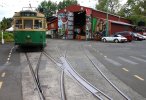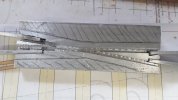justme igor
Registered
Just like the title says, bold question.
Most of you know (i think), know that i am building my own track, as precise as possible as close as i can to the real life thing.
Dispite all the written info and explanations giving, i can not make a clear image in my head on how to build that.
The first two turnouts where a slight failure, but with every build there where some major improvements.
Number 5 must could be a success?
I saw some pictures scattered over the forum today, that give some help/food for my thoughts.
I have some trouble to find the right pictures taking from above from turnouts, crossings, slip double slip and what ever comes in mind.
Some pictures that are covering the whole turnout, crossing, slip and the rest, taking directly above.
Some close ups on the frogs (including some track) and points, taking directly above, could be very helpful for me to make my next experimental turnout.
Its just to give me some extra ideas for construction.
A close look on my n scale tracks just not give me the solution i need: 3d printing all the frogs including pockets to seat the rail in, that is something i really would like to avoid

The yellow plastic are 5mm fillers, those are going to be 3mm
The approach of the frog is way to wide.
I am not really satisfied by this.

Throw-bar and toes will get also a major upgrade, that one is clear.
Thanks in advance and for the trouble, best Igor
Most of you know (i think), know that i am building my own track, as precise as possible as close as i can to the real life thing.
Dispite all the written info and explanations giving, i can not make a clear image in my head on how to build that.
The first two turnouts where a slight failure, but with every build there where some major improvements.
Number 5 must could be a success?
I saw some pictures scattered over the forum today, that give some help/food for my thoughts.
I have some trouble to find the right pictures taking from above from turnouts, crossings, slip double slip and what ever comes in mind.
Some pictures that are covering the whole turnout, crossing, slip and the rest, taking directly above.
Some close ups on the frogs (including some track) and points, taking directly above, could be very helpful for me to make my next experimental turnout.
Its just to give me some extra ideas for construction.
A close look on my n scale tracks just not give me the solution i need: 3d printing all the frogs including pockets to seat the rail in, that is something i really would like to avoid

The yellow plastic are 5mm fillers, those are going to be 3mm
The approach of the frog is way to wide.
I am not really satisfied by this.

Throw-bar and toes will get also a major upgrade, that one is clear.
Thanks in advance and for the trouble, best Igor



